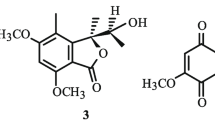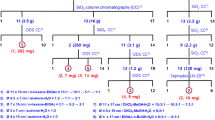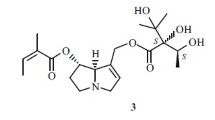Two new biphenylpropanoids (1 and 2) were isolated from the rhizomes of Acorus tatarinowii Schott. The structures of compounds 1 and 2 were determined by means of extensive spectroscopic methods. Their structures were identified as (R)-3-[1-hydroxy-3-(3,4-dimethoxyphenyl)propan-2-yl]-4,5-dimethoxy methyl benzoate (1) and (R)-3-[1-hydroxy-3-(3,4-dimethoxyphenyl)propan-2-yl]-4,5-dimethoxy ethyl benzoate (2). In addition, the xanthine oxidase (XOD) inhibitory activity of the isolated compounds was reported. Compounds 1 and 2 exhibited weak XOD inhibitory activity in the test.
Similar content being viewed by others
Avoid common mistakes on your manuscript.
Acorus tatarinowii Schott, a perennial herb, is widely distributed in eastern and southern Asia. Its rhizome is a famous traditional Chinese medicine, which has been used for more than 2000 years in China to treat rheumatism, stomachache, forgetfulness, and epilepsy. Modern pharmacological studies have shown that it has extensive bioactivities such as antibacterial, sedation, hypnosis, antidepressant, anticonvulsant, and nootropic [1]. Previous studies on the chemical components of the rhizomes of Acorus tatarinowii Schott resulted in the identification of many bioactive metabolites, including lignans, sesquilignans, phenylpropanoids, sesquiterpenoids, and alkaloids [2,3,4,5,6,7,8,9,10]. Over the course of our continuing chemical investigations on biologically active ingredients from Chinese medicinal herbs, we examined the petroleum ether extract of Acorus tatarinowii Schott, which led to the isolation of two new biphenylpropanoids. In this study, we report the isolation, structure elucidation, and XOD inhibitory activity of compounds 1 and 2 from this medicinal plant.
Compound 1, white amorphous powder, had the molecular formula of C21H26O7 as shown by HR-ESI-MS m/z 413.1572 [M + Na]+ (calcd for C21H26NaO7, 413.1576), indicative of 9 degrees of unsaturation. The 1H NMR spectrum exhibited the presence of a typical trisubstituted benzene ring with an aromatic ABX system [δ 6.63 (1H, d, J = 2.0 Hz, H-2′), 6.59 (1H, d, J = 8.0 Hz, H-5′), 6.48 (1H, dd, J = 8.0, 2.0 Hz, H-6′)], and a tetrasubstituted benzene ring with an aromatic AX system [δ 7.39 (1H, d, J = 2.0 Hz, H-4), 7.46 (1H, d, J = 2.0 Hz, H-6)]. Additionally, the 13C NMR spectrum revealed 21 carbon signals which were classified by HSQC and HMBC experiments as two aromatic rings, five methoxy groups [δ 60.1 (2-OCH3), 56.0 (3-OCH3), 51.6 (5-COOCH3), 55.3 (3′-OCH3), 55.1 (4′-OCH3)], two methylene groups [δ 63.8 (C-8), 36.3 (C-9)], and a methine group [δ 44.9 (C-7)], suggesting 1 to be a neolignan. The 1H and 13C NMR data of 1 were similar to those of (R)-4-hydroxy-3-[1-hydroxy-3-(4-hydroxy-3-methoxyphenyl)propan-2-yl]-5-methoxybenzoic acid (MBA) [2], except for the presence of another three methoxy groups (2, 5, 4′-OCH3) in 1. The suggestion was in accord with the observation of the chemical shift of C-2 signal downfield which shifted from δ 148.5 in MBA to δ 150.5 in 1, the chemical shift of C-10 signal upfield which shifted from δ 167.7 in MBA to 166.2 in 1 and the chemical shift of C-4′ signal downfield which shifted from δ 144.3 in MBA to 146.7 in 1. This was further confirmed by the HMBC correlations from 2-OCH3 to C-2, 5-OCH3 to C-10, and 4′-OCH3 to C-4′ (Fig. 1). The chirality center (7R) in 1 was suggested by circular dichroism (CD) spectrum in methanol with two negative bands at 213 and 283 nm [9]. The structure of (R)-3-[1-hydroxy-3-(3,4-dimethoxyphenyl)propan-2-yl]-4,5-dimethoxy methyl benzoate (1) is shown in Fig. 1.
Compound 2 was obtained as a white powder. HR-ESI-MS indicated that the molecular formula was C22H28O7 (m/z 427.1729 [M + Na]+, calcd for C22H28NaO7, 427.1733). The 1H and 13C NMR data of 2 were similar to those of 1, except for the presence of an ethyl group [δH 1.36 (3H, t, J = 7.8 Hz), 4.32 (2H, q, J = 7.8 Hz); δC 14.1, 61.5] in 2, instead of a methyl group [δH 3.79 (3H, s); δC 51.6] in 1. This was revealed by the 1H–1H correlations of the spin system CH3 [δ 1.36 (3H, t, J = 7.8 Hz)]/CH2 [δ 4.32 (2H, q, J = 7.8 Hz)] as well as the HMBC correlations from CH2 [δ 4.32 (2H, q, J = 7.8 Hz)] to C-10 (Fig. 1). The relative configuration of 2 was assigned by CD experiments. Similar as in the case of 1, two negative bands 213 and 283 nm were observed in the CD spectrum of 2, suggesting a chirality center (7R) in 2. The structure of (R)-3-[1-hydroxy-3-(3,4-dimethoxyphenyl)propan-2-yl]-4,5-dimethoxy ethyl benzoate (2) is shown in Fig. 1. According to SciFinder Schloar and CA databanks, compounds 1 and 2 are new compounds.
Compounds 1 and 2 were examined for their inhibitory activities on xanthine oxidase (XOD). Allopurinol was used as a positive control with IC50 = 1.61 μmol/L. The IC50 values for 1 and 2 were 38.14 and 49.07 μmol/L. Obviously, compounds 1 and 2 showed weak XOD inhibitory activity.
Experimental
General. UV were recorded on a Hewlett-Packard HP-845 UV-VIS spectrophotometer (Palo Alto, USA). CD spectra were recorded with a Jasco J-815 spectropolarimeter (Maryland, United States). Optical rotations were measured using a JASCO P-1010 digital polarimeter (Japan) and IR spectra were obtained from a Perkin Elmer Spectrum One FT-IR spectrometer (England). MS on a Finnigan LCQ Advantage Spectrometer (Thermo Scientific, USA) and a Shimadzu GC-MS model QP2010 Plus spectrophotometer (Japan), respectively. NMR spectra were recorded on a 400 MHz FT-NMR spectrometer (Varian Inova AS 400, USA) with TMS as the internal standard. Column chromatography separations were carried out on silica gel (200–300 mesh, Qingdao Haiyang Chemical Co. Ltd., Qingdao, P. R. China), ODS (50 mesh, AA12S50, YMC), MCI-gel CHP 20P (35–75 μm, Japan) and Diaion HP-20 (Pharmacia, Peapack, New Jersey, USA). The TLC analysis was carried out using a Kiesel gel 60 F254 and RP-18 F254S plates (Merck), and a UV lamp (Spectroline Model ENF-240 C/F, Spectronics Corporation, USA) and 10% H2SO4 solution were used for detection.
Plant Material. The dried rhizomes of Acorus tatarinowii Schott were collected in Guilin, Guangxi Province of China in 2021, and were identified by Prof. Wen-qing Yin (Ministry of Education Key Laboratory of Chemistry and Molecular Engineering of Medicinal Resource, Guangxi Normal University). A voucher specimen (No. 20210601) was been deposited in the authors’ laboratory.
Extraction and Isolation. The dry rhizomes of Acorus tatarinowii Schott (20 kg) were extracted three times under reflux with 95% aqueous EtOH. The EtOH extracts were concentrated under vacuum to afford a residue (2.6 kg). The residue was suspended in H2O; then the suspension was partitioned with petroleum ether (PE), EtOAc, and n-BuOH, respectively. The organic solvents were evaporated under reduced pressure to provide extracts of PE fraction (394 g), EtOAc fraction (483 g), and n-butanol fraction (396 g). The PE fraction (394 g) was subjected to silica gel column chromatography (CC) using PE–EtOAc mixtures (1:0–0:1). The eluting solutions were monitored by TLC to produce 12 fractions (Frs. 1–12). Fraction 11 (5.2 g) was applied to silica gel CC and eluted with PE–acetone (5:1–0:1) to yield six subfractions (Subfr. 11.1–11.6). Subfraction 11.6 (0.83 g) was added to Sephadex LH-20 column and eluted with CHCl3–MeOH (2:1) to give ten subfractions (11.6.1–11.6.10). Subfraction 11.6.8 (0.247 g) was purified by preparative HPLC (MeOH–H2O, 90:10) to yield 1 (43 mg) and 2 (38 mg).
Compound 1, white amorphous powder, \({\left[\mathrm{\alpha }\right]}_{\mathrm{D}}^{25}\) –25.2° (c 0.20, MeOH). IR (KBr, νmax, cm–1): 2968, 2859, 1735, 1588, 1514, 1455, 1260, 1063. UV (MeOH, λmax, nm): 268. 1H NMR (400 MHz, DMSO-d6, δ, ppm, J/Hz): 7.46 (1H, d, J = 2.0, H-6), 7.39 (1H, d, J = 2.0, H-4), 6.63 (1H, d, J = 2.0, H-2′), 6.59 (1H, d, J = 8.0, H-5′), 6.48 (1H, dd, J = 8.0, 2.0, H-6′), 3.79 (3H, s, 5-COOCH3), 3.73 (3H, s, 3-OCH3), 3.63 (3H, s, 4′-OCH3), 3.61 (3H, s, 3′-OCH3), 3.58 (1H, m, H-8b), 3.52 (1H, m, H-7), 3.47 (1H, m, H-8a), 3.44 (3H, s, 2-OCH3), 2.94 (1H, m, H-9b), 2.76 (1H, m, H-9a). 13C NMR (100 MHz, DMSO-d6, δ, ppm): 128.9 (C-1), 150.5 (C-2), 149.7 (C-3), 109.1 (C-4), 122.5 (C-5), 122.8 (C-6), 44.9 (C-7), 63.8 (C-8), 36.3 (C-9), 166.2 (C-10), 131.4 (C-1′), 113.7 (C-2′), 149.1 (C-3′), 146.7 (C-4′), 112.8 (C-5′), 120.7 (C-6′), 60.1 (2-OCH3), 56.0 (3-OCH3), 51.6 (5-COOCH3), 55.3 (3′-OCH3), 55.1 (4′-OCH3). HR-ESI-MS m/z 413.1572 [M + Na]+ (calcd for C21H26O7Na, 413.1576).
Compound (2), white powder, \({\left[\mathrm{\alpha }\right]}_{\mathrm{D}}^{25}\) –25.9° (c 0.25, MeOH). IR (KBr, νmax, cm–1): 2964, 2861, 1734, 1579, 1518, 1460, 1255, 1066. UV (MeOH, λmax, nm): 268. HR-ESI-MS m/z 427.1729 [M + Na]+ (calcd for C22H28O7Na, 427.1733). 1H NMR (400 MHz, DMSO-d6, δ, ppm, J/Hz): 7.43 (1H, d, J = 2.0, H-6), 7.37 (1H, d, J = 2.0, H-4), 6.64 (1H, d, J = 2.0, H-2′), 6.59 (1H, d, J = 8.0, H-5′), 6.48 (1H, dd, J = 8.0, 2.0, H-6′), 4.32 (2H, q, J = 7.8, 5-COOCH2CH3), 3.74 (3H, s, 3-OCH3), 3.63 (3H, s, 4′-OCH3), 3.61 (3H, s, 3′-OCH3), 3.58 (1H, m, H-8b), 3.52 (1H, m, H-7), 3.47 (1H, m, H-8a), 3.46 (3H, s, 2-OCH3), 2.94 (1H, m, H-9b), 2.76 (1H, m, H-9a), 1.36 (3H, t, J = 7.8, 5-COOCH2CH3). 13C NMR (100 MHz, DMSO-d6, δ, ppm): 128.9 (C-1), 150.3 (C-2), 149.8 (C-3), 109.0 (C-4), 122.4 (C-5), 122.7 (C-6), 44.9 (C-7), 63.8 (C-8), 36.4 (C-9), 165.3 (C-10), 131.4 (C-1′), 113.8 (C-2′), 149.1 (C-3′), 146.4 (C-4′), 112.9 (C-5′), 120.6 (C-6′), 60.3 (2-OCH3), 56.0 (3-OCH3), 14.1 (5-COOCH2CH3), 61.5 (5-COOCH2CH3), 55.3 (3′-OCH3), 55.1 (4′-OCH3).
Assay of the XOD Inhibitory Activity. In order to test the XOD inhibitory activity of 1 and 2, the XOD activities with xanthine as the substrate were measured with a spectrophotometer at λmax 295 nm using the method reported previously. Allopurinol was used as a positive control with IC50 = 1.61 μmol/L [11].
References
Z. Y. Hao, G. Ni, D. Liang, Y. F. Liu, C. L. Zhang, Y. Wang, Q. J. Zhang, R. Y. Chen, and D. Q. Yu, Nat. Prod. Commun., 2, 1 (2021).
S. Liang, S. S. Ying, H. H. Wu, Y. T. Liu, P. Z. Dong, Y. Zhu, and Y. T. Xu, Bioorg. Med. Chem. Lett., 19, 4214 (2015).
W. Y. Zhang, X. L. Feng, D. Lu, H. Gao, Y. Yu, and X. S. Yao, Bioorg. Med. Chem. Lett., 4, 814 (2018).
Y. Y Lu, Y. B. Xue, J. J. Liu, G. M. Yao, D. Y. Li, B. Sun, J. W. Zhang, Y. F. Liu, C. X. Qi, M. Xiang, Z. W. Luo, G. Du, and Y. H. Zhang, J. Nat. Prod., 78 (9), 2205 (2015).
E. Gao, Z. Q. Zhou, J. Zou, Y. Yu, X. L. Feng, G. D. Chen, R. R. He, X. S. Yao, and H. Gao, J. Nat. Prod., 80 (11), 2923 (2017).
J. F. Hu and X. Z. Feng, Planta Med., 66, 662 (2000).
G. Ni, G. R. Shi, D. Zhang, N. J. Fu, H. Z. Yang, X. G. Chen, and D. Q. Yu, Planta Med., 82, 632 (2016).
X. L. Feng, Y. Yu, H. Gao, Z. Q. Mu, X. R. Cheng, W. X. Zhou, and X. S. Yao, Rsc. Adv., 79, 42071 (2014).
Y. Y. Lu, Y. B. Xue, S. J. Chen, H. C. Zhu, J. W. Zhang, X. N. Li, J. P. Wang, J. J. Liu, C. X. Qi, G. Du, and Y. H. Zhang, Sci. Rep., 1, 1 (2016).
Z. J. Wang, Y. Y. Zhu, X. Yi, Z. S. Zhou, Y. J. He, Y. Zhou, Z. H. Qi, D. N. Jin, L. X. Zhao, and X. D. Luo, J. Ethnopharmacol., 261, 113119 (2020).
L. P. Lin, W. Qu, and J. Y. Liang, Chin. Chem. Lett., 22, 697 (2011).
Acknowledgment
This work was financed by the Guangdong Provincial key Discipline Scientific Research Project (2019-GDXK-0025 and 2021ZDJS035); the Lingnan Normal University-level Talent Project (Grant Nos. ZL1801 and QL1401); the Yanling Excellent Young Teacher Program of Lingnan Normal University (Grant No. YL20200210).
Author information
Authors and Affiliations
Corresponding author
Additional information
Published in Khimiya Prirodnykh Soedinenii, No. 4, July–August, 2023, pp. 576–578.
Rights and permissions
Springer Nature or its licensor (e.g. a society or other partner) holds exclusive rights to this article under a publishing agreement with the author(s) or other rightsholder(s); author self-archiving of the accepted manuscript version of this article is solely governed by the terms of such publishing agreement and applicable law.
About this article
Cite this article
Huang, L., Zhou, Z. & Lin, S. Two New Biphenylpropanoids from the Rhizomes of Acorus tatarinowii. Chem Nat Compd 59, 686–688 (2023). https://doi.org/10.1007/s10600-023-04087-4
Received:
Published:
Issue Date:
DOI: https://doi.org/10.1007/s10600-023-04087-4





